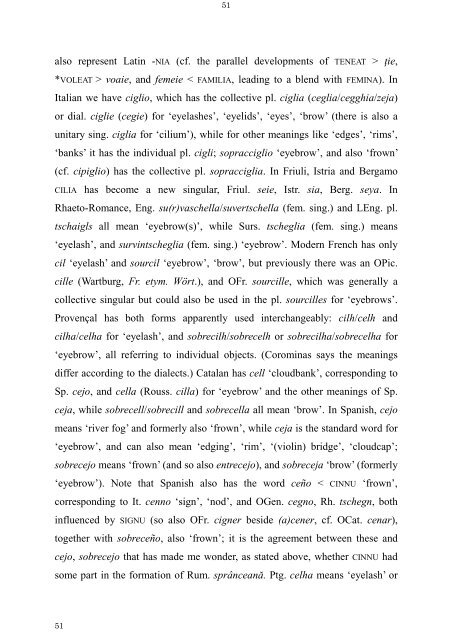The Latin Neuter Plurals in Romance - Page ON
The Latin Neuter Plurals in Romance - Page ON
The Latin Neuter Plurals in Romance - Page ON
Create successful ePaper yourself
Turn your PDF publications into a flip-book with our unique Google optimized e-Paper software.
51<br />
51<br />
also represent <strong>Lat<strong>in</strong></strong> -NIA (cf. the parallel developments of TENEAT > Ńie,<br />
*VOLEAT > voaie, and femeie < FAMILIA, lead<strong>in</strong>g to a blend with FEMINA). In<br />
Italian we have ciglio, which has the collective pl. ciglia (ceglia/cegghia/zeja)<br />
or dial. ciglie (cegie) for ‘eyelashes’, ‘eyelids’, ‘eyes’, ‘brow’ (there is also a<br />
unitary s<strong>in</strong>g. ciglia for ‘cilium’), while for other mean<strong>in</strong>gs like ‘edges’, ‘rims’,<br />
‘banks’ it has the <strong>in</strong>dividual pl. cigli; sopracciglio ‘eyebrow’, and also ‘frown’<br />
(cf. cipiglio) has the collective pl. sopracciglia. In Friuli, Istria and Bergamo<br />
CILIA has become a new s<strong>in</strong>gular, Friul. seie, Istr. sia, Berg. seya. In<br />
Rhaeto-<strong>Romance</strong>, Eng. su(r)vaschella/suvertschella (fem. s<strong>in</strong>g.) and LEng. pl.<br />
tschaigls all mean ‘eyebrow(s)’, while Surs. tscheglia (fem. s<strong>in</strong>g.) means<br />
‘eyelash’, and surv<strong>in</strong>tscheglia (fem. s<strong>in</strong>g.) ‘eyebrow’. Modern French has only<br />
cil ‘eyelash’ and sourcil ‘eyebrow’, ‘brow’, but previously there was an OPic.<br />
cille (Wartburg, Fr. etym. Wört.), and OFr. sourcille, which was generally a<br />
collective s<strong>in</strong>gular but could also be used <strong>in</strong> the pl. sourcilles for ‘eyebrows’.<br />
Provençal has both forms apparently used <strong>in</strong>terchangeably: cilh/celh and<br />
cilha/celha for ‘eyelash’, and sobrecilh/sobrecelh or sobrecilha/sobrecelha for<br />
‘eyebrow’, all referr<strong>in</strong>g to <strong>in</strong>dividual objects. (Corom<strong>in</strong>as says the mean<strong>in</strong>gs<br />
differ accord<strong>in</strong>g to the dialects.) Catalan has cell ‘cloudbank’, correspond<strong>in</strong>g to<br />
Sp. cejo, and cella (Rouss. cilla) for ‘eyebrow’ and the other mean<strong>in</strong>gs of Sp.<br />
ceja, while sobrecell/sobrecill and sobrecella all mean ‘brow’. In Spanish, cejo<br />
means ‘river fog’ and formerly also ‘frown’, while ceja is the standard word for<br />
‘eyebrow’, and can also mean ‘edg<strong>in</strong>g’, ‘rim’, ‘(viol<strong>in</strong>) bridge’, ‘cloudcap’;<br />
sobrecejo means ‘frown’ (and so also entrecejo), and sobreceja ‘brow’ (formerly<br />
‘eyebrow’). Note that Spanish also has the word ceño < CINNU ‘frown’,<br />
correspond<strong>in</strong>g to It. cenno ‘sign’, ‘nod’, and OGen. cegno, Rh. tschegn, both<br />
<strong>in</strong>fluenced by SIGNU (so also OFr. cigner beside (a)cener, cf. OCat. cenar),<br />
together with sobreceño, also ‘frown’; it is the agreement between these and<br />
cejo, sobrecejo that has made me wonder, as stated above, whether CINNU had<br />
some part <strong>in</strong> the formation of Rum. sprânceană. Ptg. celha means ‘eyelash’ or









